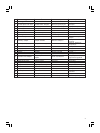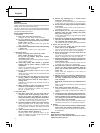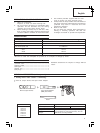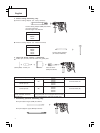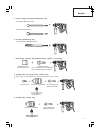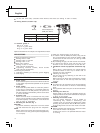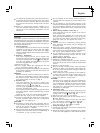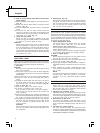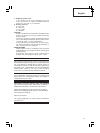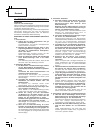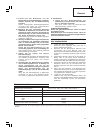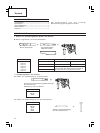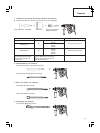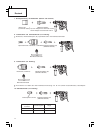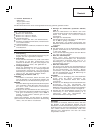
11
English
8. How to use the drill bit (taper shank) and the taper
shank adapter
(1) Mount the taper shank adapter to the rotary hammer.
(Fig. 12)
(2) Mount the drill bit (taper shank) to the taper shank
adapter. (Fig. 12)
(3) Turn the switch ON, and drill a hole in prescribed
depth.
(4) To remove the drill bit (taper shank), insert the
cotter into the slot of the taper shank adapter and
strike the head of the cotter with a manual hammer
supporting on a rests. (Fig. 13)
9. Using the side handle
When you wish to change a position of the side
handle, turn grip of the side handle counterclockwise
to loosen it, and then fasten it firmly.
CAUTION:
When boring a hole, there can be a case where the
machine attempts to rotate by the reaction at the
time of penetrating a concrete wall and/or when a
tip of the blade comes in contact with the rebar.
Firmly fasten the side handle and hold the machine
with both of your hands. Unless you hold it securely,
an accident can occur.
HOW TO USE THE CORE BIT
(FOR LIGHT LOAD)
When boring penerating large holes use the core bit (for
light loads). At that time use with the center pin and the
core bit shank provided as optional accessories.
1. Mounting
CAUTION
Be sure to turn power OFF and disconnect the plug
from the receptacle.
(1) Mount the core bit to the core bit shank. (Fig. 14).
Lubricate the thread of the core bit shank to facilitate
disassembly.
(2) Mount the core bit to the rotary hammer (Fig. 15).
(3) Insert the center pin into the guide plate until it
stops.
(4) Engage the guide plate with the core bit, and turn
the guide plate to the left or the right so that it
does not fall even if it faced downward. (Fig. 16).
2. How to bore (Fig. 17)
(1) Connect the plug to the power source.
(2) A spring is installed in the center pin.
Push it lightly to the wall or the floor straight.
Connect the core bit tip flush to the surface and
start operating.
(3) When boring about 5 mm in depth the position of
the hole will be established. Bore after that removing
the center pin and the guide plate from core bit.
(4) Application of excessive force will not only expedite
the work, but will deteriorate the tip edge of the
drill bit, resulting in reduced service life of the
rotary hammer.
CAUTION
When removing the center pin and the guide plate,
turn OFF the switch and disconnect the plug from
the receptacle.
3. Dismounting (Fig. 18)
Remove the core bit shank from the rotary hammer
and strike the head of the core bit shank strongly
two or three times with a manual hammer holding
the core bit, then the thread becomes loose and
the core bit can be removed.
GREASE REPLACEMENT
This machine is full air-tight construction to protect
against dust incursion and to prevent lubricant leakage.
This machine can be used without grease replenishment
for an extended period of time. However, perform the
grease replacement to extend the service life. Replace
the grease as described below.
1. Grease Replacement Period
You should look at the grease when you change
the carbon brush. (See item 4 in the section
MAINTENANCE AND INSPECTION.)
Ask for grease replacement at the nearest authorized
Hitachi Service Center.
In the case that you are forced to change the grease
by yourself, please follow the following points.
2. How to replace grease
CAUTION:
Before replacing the grease, turn the power off and
pull out the plug from the receptacle.
(1) Disassemble the crank cover and thoroughly wipe
off the old grease inside. (Fig. 19)
(2) Supply 30g of Hitachi Electric Hammer Grease A
(standard accessory, contained in tube) in the crank
case.
(3) After replacing the grease, reassemble the crank
cover securely. At this time, do not damage or lose
the oil seal.
NOTE:
The Hitachi Electric Hammer Grease A is of the low
viscosity type. When the grease is consumed,
purchase from the authorized Hitachi Service
Center.
MAINTENANCE AND INSPECTION
1. Inspecting the drill bits
Since use of a dull tool will cause motor
malfunctioning and degraded efficiency, replace the
drill bit with new ones or resharpen them without
delay when abrasion is noted.
2. Inspecting the mounting screws:
Regularly inspect all mounting screws and ensure
that they are properly tightened. Should any of the
screws be loose, retighten them immediately. Failure
to do so could result in serious hazard.
3. Maintenance of the motor
The motor unit winding is the very heart” of the
power tool. Exercise due care to ensure the winding
does not become damaged and/or wet with oil or
water.
4. Inspecting the carbon brushes
For your continued safety and electrical shock
protection, carbon brush inspection and replacement
on this tool should ONLY be performed by a HITACHI
AUTHORIZED SERVICE CENTER.




